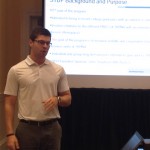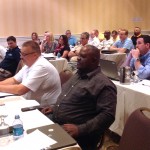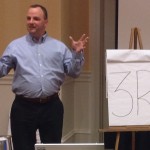Fracking is a slang term for hydraulic fracturing, a process that maximizes the output of natural gas and oil wells to make them productive.
How does hydraulic fracturing work?
When a well is fractured, an operator pumps a mixture of water, sand and a small amount
of chemicals into an oil or gas formation deep underground and applies pressure. The pressure fractures rock layers, releasing oil or gas reserves. The sand holds the fractures open to continue allowing the oil or gas to flow into the well.

As gas or oil comes to the well head under pressure, it brings with it the fracturing water that was pumped, along with natural brines that are present in the deeper layers of the earth. That “flowback” water is separated from the gas and oil at the surface, contained in steel tanks, and sent to deep injection wells for disposal.
Is hydraulic fracturing new?
No. Gas and oil operators have been using hydraulic fracturing around the country since it’s invention by George Mitchell in the late 1940s. (See article link below)
One popular method for creating fractures is the use of frac ports and sliding sleeves. Open hole packers isolate different sections of the horizontal well. A sliding sleeve is placed between each packer pair and is opened by injecting a ball inside the borehole. Typically, a completion string is placed inside the well. The string includes frac ports and open hole packers spaced to specifications.
Frac balls, typically made from an Engineering Plastic, are critical components in cutting edge downhole tooling used in hydraulic fracturing operations. Typically when creating multiple fractures in a wellbore, a completion string is placed inside the borehole with frac ports and sliding sleeves spaced between each section. In order to actuate each sleeve a properly sized frac ball is pumped along with the fracturing fluid inside the well.
Each ball is smaller than the opening in each of the previous sleeves but larger than the hole in the sleeve it is intended to open. The ball shall seat within the sleeve, closing the hole and exerting pressure to slide open the sleeve, opening the frac ports. Once the ports are open the fracturing fluid is diverted to the open hole space outside of the completion assembly causing the surrounding formation to fracture.
At the completion of each fracturing stage, the next sized ball is injected into the well causing the next sleeve to open and so on until all of the sleeves are open and multiple fractures are created within the well. The main advantages of this process being the speed with which the well can be penetrated hence reducing cost.
Engineering Plastics used in Hydraulic Fracturing
- PEEK
- TORLON®
- G10-G11-FR4
- DuPont™ Vespel®
The Engineering Plastics listed above are commonly found in seals, bushings, thrust washers, back-up rings, and logging tools. Many have properties that provide longer wear and high temperature resistance than more traditional materials.
As in nearly all industries today, Engineered Plastics are becoming widely accepted as a solution to bearing and wear issues. The oil and gas industry is no exception. Engineered Plastics have been found to alleviate some headaches in the extreme conditions the oil and gas industry meets when drilling deeper to tap into new resources.
Kendall Montague
National Sales Manager Oil & Gas
Thyssenkrupp Materials NA AIN Plastics Division
Connect with me on LinkedIn
Links to Related Items:
Animation of Baker Hughes completion and frac ball application. Frac Ball Application by Baker Hughes
Related Article: George Mitchell – The Inventor of Fracking
ThyssenKrupp Materials NA AIN Plastics Division is a sponsor of the Energy Rubber Group
Like this:
Like Loading...



 “Making the World a Brighter Place”
“Making the World a Brighter Place”


 then onto ThyssenKrupp Industrial Services, next up was ThyssenKrupp Aerospace and I also spent a week at KenMac Metals. Through the rotations, I had the opportunity to go on sales calls and see the applications of our materials for TKMNA. I saw everything from cranial baby helmets being produced to seeing the F-150 stamping plant and touring the Boeing facility that could fit 75 NFL football fields inside it to riding along on the BMW test track!
then onto ThyssenKrupp Industrial Services, next up was ThyssenKrupp Aerospace and I also spent a week at KenMac Metals. Through the rotations, I had the opportunity to go on sales calls and see the applications of our materials for TKMNA. I saw everything from cranial baby helmets being produced to seeing the F-150 stamping plant and touring the Boeing facility that could fit 75 NFL football fields inside it to riding along on the BMW test track!


















